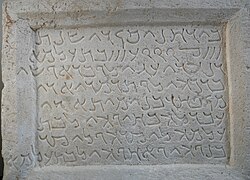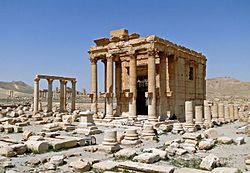Palmyra
Palmyra was an ancient city in central Syria. It is in an oasis 215 kilometres (134 miles) northeast of Damascus and 180 km (110 mi) southwest of the Euphrates.
تدمر | |
| Alternate name | Tadmor |
|---|---|
| Location | Tadmur, Homs Governorate, Syria |
| Region | Syrian Desert |
| Coordinates | 34°33′05″N 38°16′05″E / 34.55139°N 38.26806°ECoordinates: 34°33′05″N 38°16′05″E / 34.55139°N 38.26806°E |
| Type | Settlement |
| Part of | Palmyrene Empire |
| Area | 80 ha (200 acres) |
| History | |
| Founded | 3rd millennium BC |
| Abandoned | 1932 |
| Periods | Middle Bronze Age to Modern |
| Cultures | Aramaic, Arabic, Greco-Roman |
| Site notes | |
| Condition | Ruined |
| Ownership | Public |
| Management | Syrian Ministry of Culture |
| Public access | Inaccessible (in a war zone) |
| Official name | Site of Palmyra |
| Type | Cultural |
| Criteria | i, ii, iv |
| Designated | 1980 (4th Session) |
| Reference no. | 23 |
| Region | Arab States |
| Endangered | 2013–present.[1] |
History
It was an important city in ancient times. It had long been a place for travellers to stop when crossing the Syrian Desert. The city was founded some time during the 2nd millennium BC. It became abandoned around 1929. The site was made a World Heritage Site by UNESCO in 1980.
The Semitic name of the city is Tadmur (Arabic: تدمر). In Aramaic,[2] which means "a city that cannot be defeated".[3] The earliest written reference to the city by this name is on Babylonian tablets found in Mari. It is still known as Tadmur in Arabic.[4][5]
The people of Palmyra worshipped many gods and goddesses from Mesopotamia, Syria, Arabia and Greece.[6] They built a series of temples and large monuments containing funerary art, which represents the dead. The Palmyrans originally spoke Aramaic but later began speaking Greek.
The area was later made a part of the Roman Empire. The city was important because of the silk commerce from Rome to China, in eastern Asia. Between 260 and 273, Odaenathus and his wife Zenobia used Palmyra as the capital of the Palmyrene Empire, a breakaway portion of the Roman Empire. In 273 emperor Aurelian defeated her and destroyed the city. Later, emperor Diocletian restored it. This period of Roman history is called the Crisis of the Third Century.
During the Muslim conquests, a few Arab tribes had been living in Palmyra.[7]
The city lost its importance after the 16th century. It had been fully abandoned by 1929, after the end of the Ottoman Empire. There, Tadmur, was built nearby, south of the ruins.[8]
During the Syrian Civil War in 2015, the Islamic State (ISIS) destroyed large parts of the ancient city. It was recaptured by the Syrian Army in 2017.
Palmyra Media
Temple of Nabu, in CE.2010
Notes
- ↑ Baghdadi 2015.
- ↑ Hillers & Cussini, Delbert & Eleonora (2005). A journey to Palmyra: collected essays to remember Delbert R. Hillers. Brill. pp. 195–196. ISBN 978-90-04-12418-9.
- ↑ Palmyra (Syria) - Britannica Online Encyclopedia Retrieved 2008-11-16.
- ↑ "Tadmor: Syria". Geographical Names. Retrieved 2011-09-24.
- ↑ "Tedmor: Syria (ancient site)". Geographical Names. Retrieved 2011-09-24.
- ↑ Teixidor, Javier (1979). The pantheon of Palmyra. Brill Archive. p. 34, 59, 62. ISBN 978-90-04-05987-0.
- ↑ Shahîd, Irfan. Byzantium and the Arabs in the Sixth Century, Volume 2, Part 2. p. 256.
- ↑ "Tedmor: Syria (populated place)". Geographical Names. Retrieved 2011-09-24.
Bibliography
| Wikimedia Commons has media related to Lua error in Module:Commons_link at line 62: attempt to index field 'wikibase' (a nil value).. |
- Burns, Ross (1999). Monuments of Syria. London and New York: I.B. Tauris. pp. 162–175.
- Isaac, Benjamin (2000). The Limits of Empire - the Roman Army in the East (revised ed.). Oxford: Clarendon Press.






